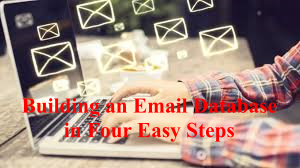Building an Email Database in Four Easy Steps

Building an Email Database in Four Easy Steps
All marketers today need a customer email database to be successful. Whether a business has one or is just getting started, is launching a new product extension or has let its file lapse, email databases can be revved up and revived in just 90 days. Here’s how.
Step 1: Ask for Email Addresses at Every Customer Touchpoint
For new customers, ensure that online registration pages, mobile apps, Facebook and Twitter pages and loyalty program sign-up documents all ask for a person’s email address.
For new customers, put a line on billing statements encouraging them to sign up and give their email address online or through customer service. Provide an incentive such as $5 off their next order. Train customer service representatives to ask for an email address after they have successfully handled a customer’s question or problem.
Have retail cashiers put take-one cards into bags at the point of sale. Provide an in-store kiosk, and hang signs in windows or in various departments throughout retail locations.
Step 2: See Out Like-Minded Marketers and Customers
Experienced, reputable list rental companies offer email append services that can add email addresses to existing records. Many also rent opt-in and double-opt-in email addresses.
Another great method available today is co-registration. Partner with organizations that have similar customer bases to add a sign-up section at the bottom of their online registration page. Keep it short and offer an incentive such as, “Sign up for email alerts and receive $5 off purchase.”
Provide a “forward to a friend” option on all email marketing campaigns and incent customers to pass emails along.
Step 3: Use Email Messages to Keep the Relationship Fresh
There’s a golden rule when it comes to sales leads — the longer you have them and don’t use them, the colder they get. The same applies to email addresses. It’s critical to start using them as soon as they are received, and to continue to use them as often as the need warrants or customers want them.
Start by automating everything possible. Automate rules and processes for things such as welcome messages for people who have just signed up; acknowledgement of their customer service request with a “promise to respond” timeframe; receipts for payment, or notifications that an automatic payment is coming up.
Send out regular promotional messages tailored to their purchase behavior. Try to upgrade them from their typical spending patterns. For example, CVS gives loyalty program members coupons for $3 off a purchase of $15 or more. Those who respond well are upgraded to “$5 off $20” or “$5 off $30”. If those offers do not elicit a response, or if customers’ spending activity slows down, they will shift that person back to the $3/$15 offer.
Also, try to get people to spend across product lines. For instance, if they buy chips, add a soda offer. If they buy sneakers, offer socks or a second pair for half off, etc.
Finally, try to keep email messages as relevant as possible. For instance, if they haven’t purchased recently, tell them “we miss you.” If they have just made a recent purchase, say “thank you.” If they’ve bought leather shoes, provide information on how to keep their leather shoes shining and lasting longer.
Step 4: Integrate Email Marketing into a Complete Marketing Program
Remember that email should not exist in a vacuum. Companies should work email seamlessly into the overall marketing strategy at the planning stage. To ensure cohesiveness, include the email campaign manager at the planning table along with the company’s traditional and other agencies.
Email campaigns should enhance and compliment all the ways companies speak with customers. Email marketing is a vital component of all marketing efforts today. By building an email program correctly from the ground up, marketers will be positioning it and themselves for continued success over the long-term.

